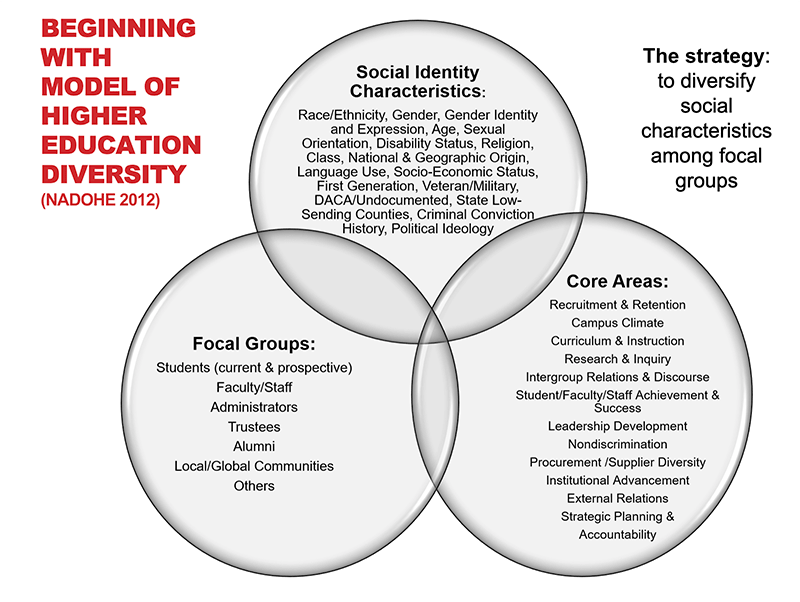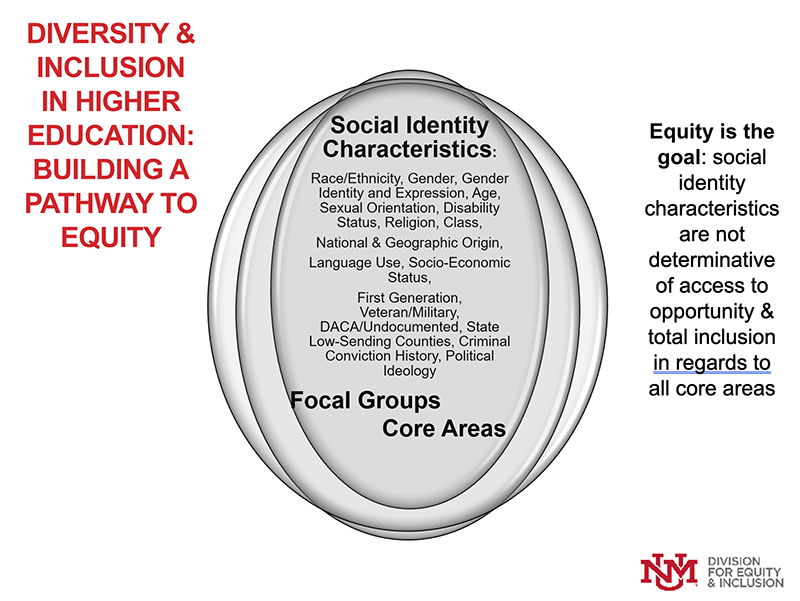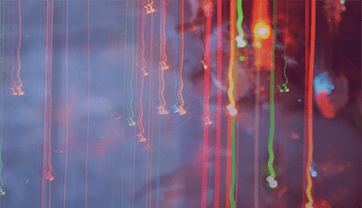UNM-GALLUP DIVERSITY SERIES: CONSIDERATIONS FOR BUILDING AN INCLUSIVE CLIMATE AT UNM-GALLUP
This second article in our series to address issues and topics surrounding diversity on campus discusses the importance of diversity in higher education, benefits of diversity to innovation, and further exploration of efforts contained within the UNM 2040 strategic plan. Our UNM-Gallup Diversity Series—previously scheduled as an on-campus summit—is now a virtual discussion to keep these important conversations on diversity issues at the forefront to improve our understanding and the actions we can take to ensure an inclusive UNM-Gallup campus for all.
BY ASSATA ZERAI, PH.D. // UNM VICE PRESIDENT FOR EQUITY & INCLUSION
CONSIDERATIONS FOR BUILDING AN INCLUSIVE CLIMATE AT UNM-GALLUP
Categories: Students Faculty Staff Community
September 14, 2020 - Enhancing experiences of the faculty, personnel, and students of UNM-Gallup campus is such an important area of focus for all of us at the University of New Mexico, and it is with great pleasure that I join in this diversity series to talk about the important considerations for building an inclusive climate at UNM-Gallup.
Utilizing an equity and inclusion lens to expand opportunity and cultivate genius at UNM requires leveraging the community wealth of our students, faculty, and personnel. The university’s efforts to ensure success in cultivating an effective and inclusive climate includes several goals.
- Diversifying Faculty: Building more diverse pools for faculty and staff searches and providing resources to colleges and schools to create stronger pathways to tenure-track faculty positions.
- Enriching Diverse and Inclusive Climates in Units: Working with college-level diversity officers on climate issues in units and planning for a 2021-22 university climate survey.
- Strengthening Relationships with Mentors and Supervisors: Educating administrators, faculty, and personnel to be better mentors, supervisors, and colleagues to all employees—and to underrepresented racial/ethnic minority (URM) and women employees specifically.
- Enhancing Student Academic Success: Improving our students’ wellbeing, academic success, and sense of belonging.
Model of Higher Education Diversity

It is important to be explicit at the outset about the community that we want to strengthen. The National Association of Diversity Officers in Higher Education (NADOHE) offers a three-dimensional model of higher education diversity (Worthington 2012). For equity and inclusion at UNM, it is evident that stakeholders are inclusive of the intersectionality of many characteristics, some include: race (including “street race” [López 2017]), ethnicity, class, gender, national and geographic origin, immigrant status, sexual orientation and gender identity and expression, foster care experience, unsheltered/homeless status, disability status, religion, language use, socioeconomic status, first generation immigration status, tribal enrollment status, first generation college, veteran/military, DACA/undocumented, rural areas of NM and underrepresented counties of the state at UNM, criminal conviction history, and political ideology.
Recent calls for proposals from the National Science Foundation have called attention to the critical importance of intersectionality in diversity, equity, and inclusion (DEI) efforts (NSF 2020). To address intersectionality, the types of questions to consider include:
- Though a high percentage of women are gaining entry into jobs in the university, are women of color gaining the same types of promotional opportunities as white men—and are there salary discrepancies?
- How are difficulties of promotion and tenure amplified for women who also have a disability?
- How about addressing the physical infrastructure and assets for our undergraduate students: Are these designed for women students who are also working mothers or single mothers in mind?
We need to make sure that we are asking these kinds of questions and setting policy and practice in ways that will facilitate responding to the unexpected. As noted by NADOHE, these social characteristics can be found in various focal groups (as indicated by circle 2 in the above illustration). In fact, it is our goal to diversify the social identities represented in those focal groups. And, to promote their inclusion in core areas such as recruitment that focuses on families and communities—and not just the individual.
Our goal is a campus climate that is welcoming, a curriculum that teaches us about ourselves as well as to appreciate the culture of others, instruction that is culturally responsive, procurement practices that encourage the use of minority- and women-owned businesses, advancement that promotes alumni engagement from diverse backgrounds, and accountability that includes metrics to assess diversity performance goals.

As shown by NADOHE, equity is the goal. We know that we have arrived at an equitable state when social identity characteristics do not determine access and opportunity—and when there is total inclusion in all core areas (Worthington 2012).
Why Does Diversity Matter
For UNM, diversity benefits our mission. We know that diverse groups are more productive, creative, and innovative (Herring 2009). Diverse groups generate higher-quality ideas (McLeod, et al. 1996; Loyd et al 2013; de Vaan et al 2015). And the level of critical analysis of decisions and alternatives is higher in groups exposed to minority viewpoints (Sommers, et al., 2006; Loyd, et al. 2013; van Dijk, et al., 2017). That’s why we want our representation at UNM and its Branch campuses to reflect the diversity of the communities where we live and work. We want our people to feel that they belong and are respected—and that they bring value and are encouraged to thrive.
Diversity and inclusion foster innovation (Bell, et al. 2011; Hofstra, et al. 2020). Citing human resource management literature, the Society for Women Engineers (SWE 2014) argues that diversity and inclusion are synergistic. Diversity does not work without inclusion and vice versa. We also know that “decision-making improves when teams embrace different points of view ; independence of thought; and the sharing of specialized knowledge…. Diverse groups also do better on sophisticated problem-solving tasks than homogeneous groups because accommodating different experiences breaks down the risk of groupthink…. Groups that make the time to openly discuss conflict and that want to learn from all perspectives can reap the greatest benefits of diversity through the development of an inclusive culture” (Society for Women Engineers and ARUP [a London-based engineering firm] 2014).
Consistent with SWE (2014), educational institutions suffer turnover, missed opportunities, and low morale when they lose someone’s contribution because they feel they don’t belong. Overlooking and underutilizing the full potential of students and personnel happens particularly when unconscious bias is at play. “At their best, diversity and inclusion efforts work together to cultivate an empathetic understanding in leaders and colleagues that allows them to value each other as individuals and as a whole people” (SWE 2014).
Advocating for Diversity, Equity, and Inclusion
While we have a model for higher education diversity—and know there are many benefits to a diverse, inclusive, and equitable campus climate—each of us within the UNM community must do our part to foster best practices.
Particularly, we must be aware of the bias we may bring to our daily tasks, decision making, and collective work that might form barriers to a welcoming climate. Some of the short cuts related to implicit bias that we should be aware of include (From University of Washington ADVANCE and Moody 2010):
- Cloning: “Replicating oneself by hiring someone with similar attributes or background. This also refers to undervaluing a candidate’s research because it is not familiar as well expecting candidates to resemble someone whom the search committee is replacing. Cloning limits the scope and breadth of approaches and perspectives in research, teaching, and service” (University of Washington ADVANCE).
- Snap Judgments: “Making judgments about a candidate with insufficient evidence. Dismissing a candidate for minor reasons or labeling a candidate “the best” and ignoring positive attributes of other candidates. Having a covert agenda furthered by stressing something trivial or focusing on a few negatives rather than the overall qualifications. Snap judgment often occurs when the hiring process feels rushed” (University of Washington ADVANCE).
- Negative Stereotypes: “Characterized by presumptions of incompetence. The work of women and underrepresented minorities is scrutinized much more than the majority of faculty at all stages of their academic career” (University of Washington ADVANCE).
- Positive Stereotypes: “Dominant group members are automatically presumed to be competent, receiving the benefit of the doubt. Their negative attributes are glossed over, and success is assumed. This bias is also called the “original affirmative action” because dominant group members are automatically presumed qualified and thereby given an unearned advantage” (University of Washington ADVANCE)..
- Euphemized Bias: “Members of dominant groups are evaluated based on their potential, whereas underrepresented groups are judged on the basis of their accomplishments and their track record only” (University of Washington ADVANCE).
(Sources: https://www.ere.net/confirmation-bias-can-get-in-the-way-of-smart-hiring-decisions/ ; http://www.engr.washington.edu/lead/biasfilm/materials/shortcuts.html and Rising above Cognitive Errors: Guidelines for Search, Tenure Review, and Other Evaluation Committees- by JoAnn Moody https://inclusion.uoregon.edu/implicitbias)
We must encourage personnel and faculty to learn about their own unconscious biases. One great way to do this is to visit the Harvard University “Project Implicit” site and take an implicit association test (see, https://implicit.harvard.edu/implicit/takeatest.html ). And take advantage of other university opportunities to continually learn more about the importance of equity and inclusion to make our workspaces and classrooms and labs more dynamic environments for diversity.
Other ideas to promote equity and inclusion include honoring the varied cultural backgrounds within the campus community and supporting personnel and faculty holistically with professional development and advancement opportunities.
Also, it is important to remember that inclusive practices are incomplete if we expect to bring employees from diverse groups to UNM-Gallup, and then ask them to simply assimilate. To be truly inclusive—and to ensure that we enjoy the intellectual benefits of diversity—we must ultimately expand workplace culture to incorporate the interests and epistemologies of employees from the many communities (domestic and international) represented within our personnel ranks.
UNM 2040 Strategic Planning: Charge to Diversity, Equity & Inclusion
We are collectively charged at UNM to develop a strategic plan that guides our diversity, equity, and inclusion efforts at UNM. We will focus on the following.
- Establish a university diversity values statement and create a process to affirm this statement on an annual basis.
- Identify and create a university-wide strategy for increasing demographic diversity.
- Work to improve climate through greater inclusion.
We are interested in ideas from the UNM-Gallup community for increasing diversity and retention of staff from racial and ethnic minority groups, LGBTQ and deaf culture communities, religious minorities, those who are veterans, persons with disabilities, women, and other groups—including employees in leadership positions.
Proposed strategies for the plan include better coordination of efforts across campuses; shared goal setting; and utilizing the Diversity Council to communicate and build a UNM-wide diversity strategy.
Invited Discussion
There are many advantages to creating an inclusive campus culture, and we look forward to working collectively throughout the university system to develop the UNM 2040 Strategic Plan. The plan will recommend effective strategies to increase diversity and inclusion UNM-Gallup. Inclusion today is the key to innovation tomorrow. Our efforts will help us to grow the reputation of UNM and produce leaders in the work force who enhance both equity and inclusion in their respective fields.
While it might be some time before we can meet in person to continue this discussion, I invite you to remain involved in the conversation. Please feel free to reach out to me with questions and suggestions—and plan to be engaged in our ongoing planning efforts throughout the rest of this year and beyond.
UNM-Gallup Article Contact:
Assata Zerai, Ph.D.
Vice President for Equity and Inclusion
Professor of Sociology
University of New Mexico
zerai@unm.edu
For campus updates and information, please visit gallup.unm.edu/news
Acknowledgements (This article is an excerpt from a presentation which quotes from and is inspired by several sources):
WISELI: Women in Science & Engineering Leadership Institute, University of Wisconsin (This article drew upon brochures prepared by Eve Fine and Jo Handelsman.)
NSF funded ADVANCE Center for Institutional Change, University of Washington for slides/resources
University of Illinois DRIVE committee and work of chair Professor Wendy Heller and grad assistant Jacqueline Yi
DiversityEdu implicit bias awareness search committee curriculum
Erin McConahey, ARUP Fellow’s presentation, “Give Me the Data: talking about unconscious bias”, University of Illinois, March 5-6, 2015
University of Washington ADVANCE Center for Institutional Change. http://www.engr.washington.edu/lead/biasfilm/materials/shortcuts.html
Bibliography:
Bell, S. T., A. J. Villado, M. A. Lukasik, L. Belau, A. L. Briggs. 2011. Getting specific about demographic diversity variable and team performance relationships: A meta-analysis. J. Manage. 37, 709–743.
De Vaan, M., D. Stark, B. Vedres. 2015. Game changer: The topology of creativity. Am. J. Sociol. 120, 1144–1194.
Herring, C. 2009. Does diversity pay? Race, gender, and the business case for diversity. American Sociological Review, 74(2), 208-224.
Hofstra, Bas, Vivek V. Kulkarni, Sebastian Munoz-Najar Galvez, Bryan He, Dan Jurafsky, Daniel A. McFarland. 2020. “The Diversity–Innovation Paradox in Science”. Proceedings of the National Academy of Sciences Apr 2020, 117 (17) 9284-9291. DOI:10.1073/pnas.1915378117
Lermusi, Yves. 2013. Confirmation Bias Can Get in the Way of Smart Hiring Decisions. . https://www.ere.net/confirmation-bias-can-get-in-the-way-of-smart-hiring-decisions/
López, Nancy, Edward Vargas, Melina Juarez, Lisa Cacari-Stone, Sonia Bettez. 2017. What’s Your “Street Race”? Leveraging Multidimensional Measures of Race and Intersectionality for Examining Physical and Mental Health Status among Latinxs. Sociology of Race and Ethnicity. 4(1), 49-66.
Loyd, D. L., Wang, C., Phillips, K. W., & Lount, R. (2013). Social category diversity promotes premeeting elaboration: The role of relationship focus. Organization Science, 24, 757-772.
McLeod, P. L., Lobel, S. A., & Cox, T. H. (1996). Ethnic diversity and creativity in small groups. Small Group Research, 27(2), 248-264.
Moody, JoAnn. 2010. Rising above Cognitive Errors: Guidelines for Search, Tenure Review, and Other Evaluation Committees. http://www.ccas.net/files/ADVANCE/Moody%20Rising%20above%20Cognitive%20Errors%20List.pdf
NSF. 2020. ADVANCE: Organizational Change for Gender Equity in STEM Academic Professions. https://www.nsf.gov/funding/pgm_summ.jsp?pims_id=5383
Society of Women Engineers (SWE) and ARUP. 2014. Diversity and Inclusion. Edited by Erin McConahey, Katherine Prater, and Jesse Vernon.
Sommers, S. R. (2006). On racial diversity and group decision making: Identifying multiple effects of racial composition on jury deliberations. Journal of Personality and Social Psychology, 90(4), 597-612.
Van Dijk, H., Meyer, B., van Engen, M., & Loyd, D. (2017). Microdynamics in diverse teams: A review and integration of the diversity and stereotyping literatures Academy of Management Annals, 11 (1), 517-557.
Worthington, R.L. 2012, “Advancing Scholarship for the Diversity Imperative in Higher Education: An Editorial,” Journal of Diversity in Higher Education, 5, p. 2. Copyright 2012 by the National Association of Diversity Officers in Higher Education.
Zerai, Assata. 2016. Intersectionality in Intentional Communities
Latest News
Zollinger Library January Events
UNM-Gallup makes progress on new Law Enforcement Academy
Zollinger Library December Events
UNM-Gallup to host Holiday in New Mexico event Dec. 4
The University of New Mexico - Gallup
705 Gurley Ave.
Gallup, NM 87301
(505) 863-7500
Explore more News options:
UNM-G News UNM-G Events Speakers Bureau Press Release Archives



